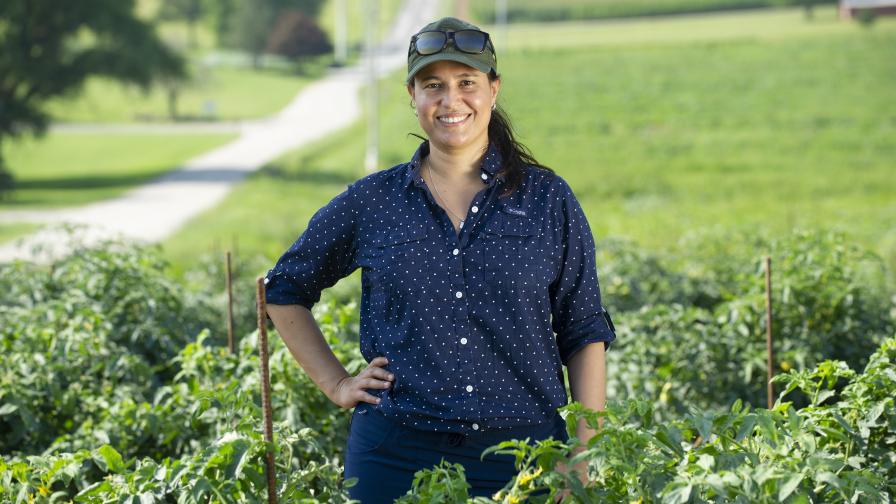How This Crop Protection Solution Is Like ‘Putting on a Coat’ for Cold-Sensitive Crops

What can fruit growers do to prevent cold damage on sensitive crops? Plant-based dispersions could be the answer.
Cold damage is No. 1 worldwide in terms of negatively impacting temperate fruit crops, according to the Food and Agriculture Organization (FAO). The “frustrating aspect” of that, according to Washington State University (WSU) Professor of Horticulture Matthew Whiting, “is that it is certainly predicted to get worse.”
In turn, the question becomes: What might growers be able to do to prevent cold damage, which more frequently is being attributed to late-winter/early-spring warming periods that release buds from endodormancy, making them susceptible to subsequent cooler temperatures?
Whiting and his WSU colleagues are working on an answer.
Plant-based dispersions (PBDs) are aqueous solutions that contain plant-derived, cellulose-based nanomaterials, such as cellulose nanocrystals (CNC). They create an insulating layer that is effective and renewable. The materials can be applied with existing spray equipment; a single treatment provides durable resistance.
WSU’s trials, which involve sweet cherry, apple, and grape, have demonstrated that, when coated with plant-based dispersions, buds are slower to lose heat into the environment than untreated buds, improving their resistance to cold temperatures.
“I always use the analogy of ‘putting on a coat,’” Whiting says.
Using differential thermal analysis (DTA), Whiting’s team has been able to determine the positive effects of PBDs on various sweet cherry varieties. “The physics [of DTA] is actually pretty simple: When tissue freezes, it’s that latent heat of fusion that is released, and these thermal electric modules pick up that temperature spike and translate it into an electrical signal,” Whiting says. “As you decrease the temperature in a programmable freeze chamber over time, you can follow these spikes, and determine when damage occurs.”
SWEET CHERRY TRIALS
Led by WSU Ph.D. candidate Brent Arnoldussen, a 2020 trial involving dormant ‘Rainier’ cherries showed significant improvement in cold tolerance among treated flower buds. At 24 hours post application, 1% and 3% CNC treatments had up to 6°F improved tolerance. At 72 hours post application, the higher concentration of CNC was especially effective, boasting an 8.7°F shift in tolerance.
“We do see efficacy within 24 hours of application,” Whiting says. “But after 48 hours and 72 hours there is something going on there that we actually get improved efficacy of the treatment.”
More recently, Whiting studied post-bud break in ‘Selah’ cherries. At 72 hours post application in the field, a 2% concentration of CNC resulted in zero damage at 23°F, whereas the control group resulted in 50% damage. At 21.2°F, the difference in damage was 30% vs. 90%; at 19.4°F it was 50% vs. 100%.
“What’s really compelling to me,” Whiting says, “is where you have about a 4- or 5-degree range that, on one end, will actually eliminate completely the untreated buds, where you still would have half a crop in a worst-case scenario in response to treatments.”
Whiting’s latest trial “scaled up” from those previous studies, which had used backpack sprayers on replicate trees. His team treated cherry trees in Mattawa, WA, at a lower volume with commercially available electrostatic sprayers.
At six days post application, the control group resulted in 50% damage at 24.8°F compared to no damage to the buds treated with 2% CNC at 22 gallons per acre at normal speeds. “What we were excited to see was that same response,” Whiting says. “They can simply handle cooler temperatures.”
Similarly successful results were seen in treated apples in Mattawa, in this case an improvement of 7.5°F.
ACTUAL FROST EVENT
Whereas each of the previous studies had ended with cut wood in the freeze chamber, Arnoldussen did conduct one trial in which the data was generated in response to a natural frost event. Using an air-blast sprayer rather than an electrostatic sprayer, he twice applied 2% PBD to ‘Early Robin’ cherries at 50 gallons per acre in Sunnyside, WA.
“Brent went out two days after the natural freeze and cut through thousands of buds and did that visual assessment — live or dead,” Whiting says. Among the untreated buds, 13.63% were dead compared to 2.9% of the treated buds. That same weekend, ‘Early Robin’ trees in Pasco, WA, were treated similarly. In this case, tree yield was examined rather than bud count, with the PDB treatment improving yield by an average of 9,000 pounds per acre.
Currently, Whiting and his colleagues are seeking to protect the intellectual property of their PBD product. More than 3,000 gallons of it have been prepared, formulated, and distributed to several growers in Washington state. They are seeking additional growers in 2023.










